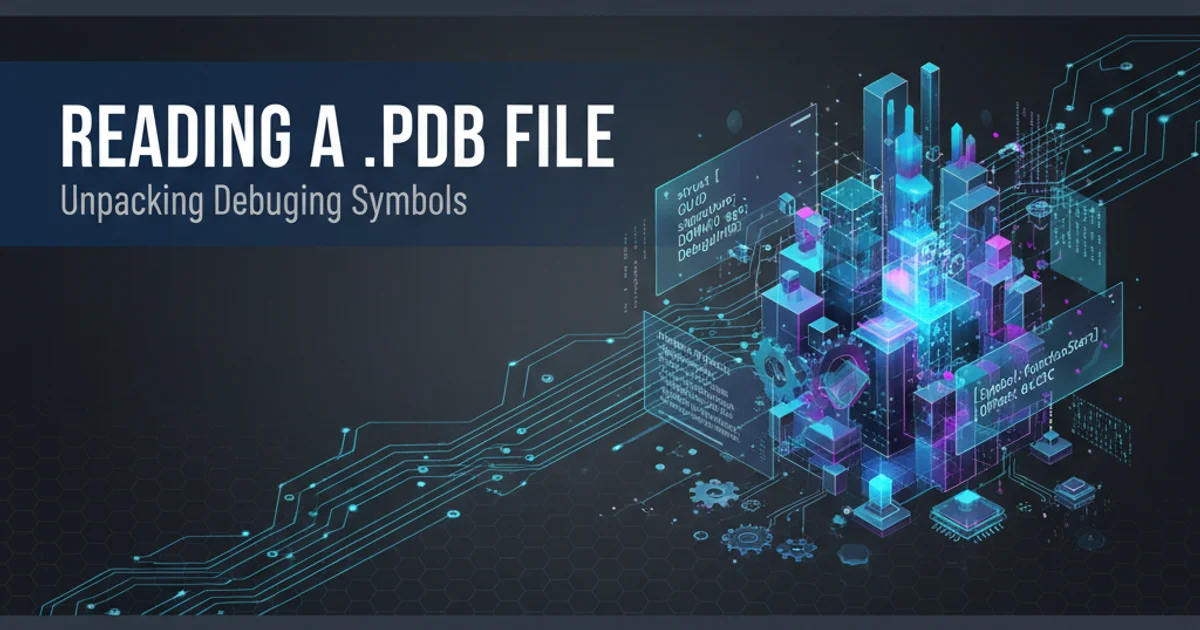Reading a .pdb file
Categories:
Understanding and Viewing .PDB Files: A Developer's Guide

Explore the structure and purpose of Program Database (.PDB) files, essential for debugging, and learn how to effectively view their contents.
Program Database (.PDB) files are crucial components in the software development lifecycle, especially for debugging compiled applications. They store symbolic and debugging information that links the compiled machine code back to the original source code. Without a .PDB file, debugging an application can be significantly more challenging, often reducing the process to disassembling machine code.
What is a .PDB File?
A .PDB file is a proprietary file format (primarily used by Microsoft development tools) that holds debugging information. This information includes details like global variables, local variables, function names, source file names, and line numbers. When you compile a program in debug mode, the compiler generates a .PDB file alongside the executable (.EXE) or library (.DLL) file. This file acts as a map, allowing debuggers to understand the compiled code in terms of the original source code.
flowchart TD
A[Source Code (.cpp, .cs)] --> B{Compiler (e.g., MSVC)}
B --> C[Executable (.exe, .dll)]
B --> D[PDB File (.pdb)]
C & D --> E[Debugger (e.g., Visual Studio Debugger)]
E --> F["Source-Level Debugging (Breakpoints, Variables)"]Relationship between Source Code, Compiler, Executable, PDB, and Debugger
Why are .PDB Files Important?
The importance of .PDB files cannot be overstated for developers. They enable:
- Source-level debugging: Step through code, set breakpoints, and inspect variables using the original source code.
- Call stack analysis: Understand the sequence of function calls leading to an error.
- Crash dump analysis: Diagnose issues from crash reports by mapping memory addresses back to source code locations.
- Performance profiling: Identify bottlenecks by linking performance data to specific functions and lines of code.
Without a .PDB file, a debugger can only show you assembly code, which is far more difficult to interpret and debug.
Viewing .PDB File Contents
While .PDB files are not designed for direct human readability, several tools allow you to inspect their contents. These tools parse the binary format and present the symbolic information in a more digestible way. The most common methods involve using Microsoft's debugging tools or specialized third-party utilities.
1. Using dumpbin.exe (Microsoft Visual Studio Command Prompt)
dumpbin.exe is a command-line tool included with Visual Studio that can display information about COFF (Common Object File Format) object files, libraries, executables, and PDB files. To view PDB information, you typically use the /PDBPATH or /SYMBOLS options, though direct detailed PDB content viewing is limited to symbol lists.
2. Using DIA2Dump.exe (Debugging Tools for Windows)
The DIA (Debug Interface Access) SDK provides an API to access PDB information. DIA2Dump.exe is a sample application built using this SDK that can dump a significant amount of information from a PDB file, including types, symbols, and source file information. This is often the most comprehensive way to programmatically inspect a PDB.
3. Using a Debugger (e.g., Visual Studio)
While not directly 'viewing' the PDB file's raw content, a debugger like Visual Studio uses the PDB to provide its debugging capabilities. By attaching to a process or loading a crash dump, the debugger interprets the PDB to show you source code, variable values, and call stacks. This is the primary intended use of a PDB file.
4. Third-Party Tools
Several third-party tools exist that can parse and display PDB information, often with a more user-friendly interface than command-line utilities. Examples include tools like PdbInspector or integrated features within reverse engineering tools.
dumpbin /PDBPATH myapplication.exe
dumpbin /SYMBOLS myapplication.pdb
Example dumpbin commands to inspect an executable's PDB path and symbols within a PDB.
DIA2Dump.exe, you typically need to compile the sample from the DIA SDK or find a pre-compiled version. It offers a much deeper dive into the PDB's internal structure than dumpbin.